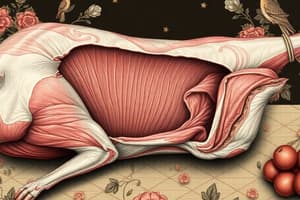Podcast
Questions and Answers
Durante el proceso de conversión de músculo a carne en cerdos, la concentración de lactato aumenta del 4% al 9% en las primeras dos horas después de la muerte.
Durante el proceso de conversión de músculo a carne en cerdos, la concentración de lactato aumenta del 4% al 9% en las primeras dos horas después de la muerte.
True (A)
El proceso de formación de rigor mortis muscular en aves conduce a un aumento en la concentración de ácido láctico dentro de la primera hora después del sacrificio.
El proceso de formación de rigor mortis muscular en aves conduce a un aumento en la concentración de ácido láctico dentro de la primera hora después del sacrificio.
True (A)
Los cerdos tienen una proporción relativamente alta de grasa intramuscular, lo que contribuye a su estructura cárnica más magra.
Los cerdos tienen una proporción relativamente alta de grasa intramuscular, lo que contribuye a su estructura cárnica más magra.
False (B)
En cerdos, la acumulación de ácido láctico se debe a la presencia de oxígeno durante el sacrificio.
En cerdos, la acumulación de ácido láctico se debe a la presencia de oxígeno durante el sacrificio.
El músculo pectoral en aves se considera uno de los cortes más tiernos entre todas las carnes de ave debido a su composición única y distribución variable de colágeno.
El músculo pectoral en aves se considera uno de los cortes más tiernos entre todas las carnes de ave debido a su composición única y distribución variable de colágeno.
Las enzimas proteolíticas, como calpaína y catepsina, se activan durante el proceso de envejecimiento de la carne de res.
Las enzimas proteolíticas, como calpaína y catepsina, se activan durante el proceso de envejecimiento de la carne de res.
La conversión de músculo a carne implica la descomposición de macromoléculas como lípidos, carbohidratos y proteínas.
La conversión de músculo a carne implica la descomposición de macromoléculas como lípidos, carbohidratos y proteínas.
El proceso de envejecimiento de la carne puede durar solo unas horas después del sacrificio del animal.
El proceso de envejecimiento de la carne puede durar solo unas horas después del sacrificio del animal.
Durante el rigor mortis muscular, las proteasas como catepsinas y caspasas descomponen las proteínas musculares en péptidos y aminoácidos.
Durante el rigor mortis muscular, las proteasas como catepsinas y caspasas descomponen las proteínas musculares en péptidos y aminoácidos.
La acumulación de ácido láctico es un factor importante en la optimización de la producción cárnica.
La acumulación de ácido láctico es un factor importante en la optimización de la producción cárnica.
Flashcards are hidden until you start studying
Study Notes
Introduction to Muscle Conversion to Meat Process
The conversion of muscle to meat involves several biological and chemical processes that result in the transformation of animal tissues into edible products. This process is critical in the meat industry, where it determines the quality, texture, taste, and safety of the final product. In this article, we will discuss the changes involved in this conversion across different species such as pigs, chickens, and cattle, along with the enzymes implicated in these transformations.
Changes in Pigs
In swine farming, the muscle conversion process begins after slaughter when pork cuts undergo rapid postmortem changes to become ready for consumption. During this period, there is an initial increase in the concentration of lactate from 4% to 9% within two hours of death. Lactic acid accumulation occurs due to glycolysis triggered by the absence of oxygen during slaughter, which leads to muscle rigor mortis and subsequent softening of the tissue.
Changes in Chickens
Similar to swine, chicken processing involves muscle rigor mortis formation, leading to an increased concentration of lactic acid within the first hour of slaughter. However, unlike pigs, chickens have a relatively low proportion of intramuscular fat, contributing to their leaner meat structure. Additionally, the breast meat is considered one of the most tender cuts of all bird meats, possibly due to its unique composition and variable collagen distribution.
Enzymatic Processes in Muscle Conversion
Several enzymes play a crucial role in the conversion of muscle to meat, including proteases, lipases, and glycosidase enzymes. These enzymes break down macromolecules like proteins, fats, and carbohydrates into smaller compounds that contribute to the unique flavor and texture of meat products. For example, proteases like cathepsins and caspases break down muscle protein into peptides and amino acids during muscle rigor mortis formation. These enzymes help soften the tissue by breaking down connective tissues like collagen and elastin.
Changes in Beef
Beef processing involves aging, which helps tenderize the meat and improve its flavor through enzymatic activity. The aging process begins after slaughter and can last from a few days to several weeks depending on the desired tenderness level. During this period, endogenous proteolytic enzymes such as calpain and cathepsin are activated, breaking down the muscle proteins into smaller molecules. This process enhances the solubility and digestibility of beef, contributing to its characteristic flavors and textures.
In conclusion, the conversion of muscle to meat is a complex biological and chemical process involving various species and enzyme systems. Understanding these changes is essential for maintaining quality, safety, and consumer preferences in the meat industry. By considering factors such as postmortem changes, lactic acid accumulation, and enzymatic processes, we can optimize meat production and ensure the best possible product for consumers.
Studying That Suits You
Use AI to generate personalized quizzes and flashcards to suit your learning preferences.




